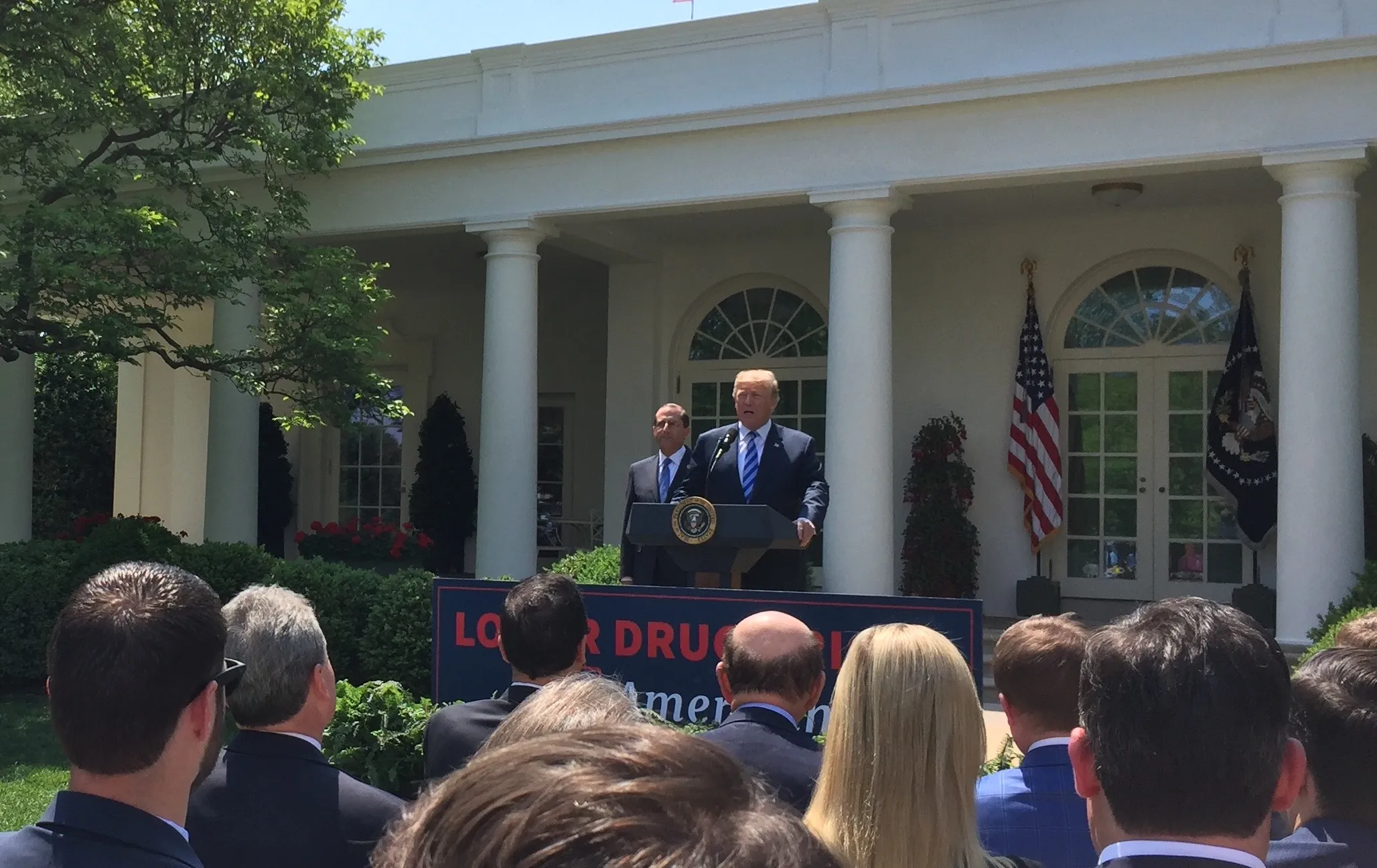Comparing FREOPP’s ‘Competition Prescription’ and Trump’s ‘Blueprint’ on Lowering Drug Prices

Historically, the debate about high prescription drug prices in the United States has suffered from partisan gridlock. Democrats have advocated federally-administered price controls as the ultimate solution to high drug prices. Republicans, philosophically opposed to price controls, have simply shrugged their shoulders and accepted high prices as the price, so to speak of avoiding more government intervention.
Breaking through partisan gridlock on drug pricing
But this is a false dichotomy, as I discussed extensively in my 2017 FREOPP white paper on drug pricing, The Competition Prescription: A Market-Based Plan for Making Innovative Medicines Affordable. In the U.S., drug prices are highest where there is no competition, either from competing therapies or from unbranded generic drugs.
And where generics are available, American drug prices are the lowest in the developed world. More than four-fifths of American prescriptions are for these affordable generic drugs. It’s that one-fifth, where monopolies largely reign, where U.S. drug prices are high.

So, the focus of The Competition Prescription is on disrupting those monopolies: removing federal barriers to competition where they exist, and tackling the problem of monopoly pricing where it otherwise exists, through more powerful negotiating tools like removing coverage mandates, expanding the range of drugs for which Medicare plans negotiate prices through Part D, and precluding Medicare drug price increases that outpace consumer inflation.
I was gratified to see that these core ideas also form the core of the drug pricing plan that President Trump and Health and Human Services Secretary Alex Azar unveiled on May 11, 2018. I discuss the details of the Trump plan in an article for Forbes. In the article you’re reading now, I’ll explain the commonalities between the FREOPP plan and the Trump plan, and also where they differ.
Removing FDA barriers to drug price competition
Where there is especially close alignment between the FREOPP plan and the Trump plan is on what the FDA can do, with its existing statutory authority and also with Congressional help, to remove barriers to competition. Here’s a table comparing the FREOPP recommendations with Trump’s:

The darker green-shaded rows are where the FREOPP ideas and Trump ideas are nearly identical. The lighter green-shaded rows are where the ideas are similar, but not identical. And the red-shaded rows are where the FREOPP approach and the Trump approach are meaningfully different. (Later on, you’ll see yellow-shaded rows, where the FREOPP and Trump approaches are different, but philosophically compatible.)
Both the FREOPP and Trump plans focus on addressing artificial monopolies created by the FDA’s risk evaluation and mitigation strategies; its regulation of generic drugs delivered by specialized devices like the EpiPen; and accelerating approval of new treatments that will bring competition to areas where there is currently a monopoly or oligopoly. The FDA, under Commissioner Scott Gottlieb, has also focused on addressing the backlog of FDA approvals for new generic drugs.
Notably, the Trump plan doesn’t address artificial monopolies created by the Orphan Drug Act, nor does it address how to make the FDA approval process for new drugs more cost-effective. (Gottlieb has announced that the FDA will unveil its strategy for modernizing the FDA in June.)
Negotiating drug prices under Medicare
Another area where the FREOPP and Trump plans are very similar is on expanding the degree to which drug prices under Medicare are negotiated. There’s a myth out there that Medicare doesn’t negotiate drug prices today; it does in the Part D program for prescriptions seniors pick up at the pharmacy, through the private insurers and pharmacy benefit managers that negotiate with drug companies.
However, drugs administered through the original Medicare programs—Part A (for hospital care) and Part B (for care delivered in physician offices)—are not negotiated.

The FREOPP plan called for ending or rolling back all mandates that force Medicare to pay for all FDA-approved drugs in a given category regardless of their value. The Trump plan also calls for rolling back these so-called “protected classes” and for eliminating the arbitrage that allows drugs administered in some sites to reap higher reimbursement rates from Medicare than from others. In addition, both the FREOPP plan and the Trump plan call for growing Part B payments for drugs at consumer inflation (CPI), and moving payment for many Part B drugs to Part D, where private insurers and PBMs can negotiate drug prices.
These are substantial reforms that, if enacted, would do a tremendous amount to reduce the power of pharmaceutical companies to enact double-digit price increases that make critical medicines less affordable for those who most need them.
Impressively, the Trump plan goes above and beyond the FREOPP plan by also addressing limitations on Medicaid rebates that incentivize greater price hikes; considering limits on drug company co-pay cards that incentivize the use of high-cost drugs, and allowing for faster mid-year substitution of generic drugs so that low-cost options are available to patients as soon as possible.
Generic & ‘biosimilar’ competition for biotech drugs
An underappreciated problem in drug pricing is the high cost of biologic or large-molecule drugs: drugs that have a complex molecular structure, usually because they are large proteins such as genetically modified antibodies. These large-molecule drugs don’t fall under the traditional regulatory pathway for generic drugs governed by the Hatch-Waxman Act of 1984. As a result, many biologic drugs whose patents have long expired have yet to be subject to vigorous generic (or “biosimilar”) competition.
The Biologics Price Competition and Innovation Act of 2009 was enacted by Congress as an attempt to modernize the FDA’s mandate for biosimilar drugs. But the biotech and pharma industries successfully watered down several provisions of the Act, such that biosimilar competition remains less robust than generic competitition in the traditional pharmaceutical market.

The FREOPP plan calls on Congress to modify the BPCI Act of 2009 to make it more like the Hatch-Waxman Act of 1984. In this way, robust generic competition for biotech drugs is more likely to emerge. The Trump plan doesn’t call for Congress to act; instead, it states that the “FDA will issue new policies to improve the availability, competitiveness, and adoption of biosimilars as affordable alternatives to branded biologics,” and educate physicians and insurers about the value of biosimilar drugs.
An area of concern is the decision by the Centers for Medicare and Medicaid Services to assign different Medicare billing codes to biosimilar drugs and the branded biotech drugs they compete with. This may seem like an obscure point, but the end result will be less price competition between biosimilars and branded drugs. CMS appears to have drunk the industry lobbyist Kool-Aid on this front, declaring that “prior approaches to biosimilar coding and payment would have created a race to the bottom of biosimilar pricing.”
Monopolies and middlemen
An area of focus for the Trump administration is attacking the middlemen, especially pharmacy benefit managers or PBMs, who it believes are extracting unfair profits from the pharmaceutical supply chain. The pharmaceutical industry, seeking to deflect blame from its pricing practices, has been at the forefront of blaming PBMs for the prices that pharma charges.
But PBMs do act in ways that aren’t aligned with patient value, especially when they accept rebates from drug companies that increase the utilization of costly drugs over more affordable alternatives. More transparency can help identify where PBMs are behaving this way; so can revisiting regulations that force insurers to use PBMs where they would be most effective in negotiating with drug companies directly.

A missed opportunity for the Trump administration was not calling for regulatory changes that would allow insurers to band together to jointly negotiate drug prices with pharmaceutical companies in a given U.S. state. Switzerland uses this approach to keep the lid on price hikes, and it works reasonably well, especially where a branded drug is the only treatment for a particular disease and thereby has monopoly pricing power.
The importance of Congressional action
The May 11 rollout by the Trump administration—understandably—focused on what the administration can achieve unilaterally, without relying on Congress. But the most significant reforms, especially of Medicare’s pricing practices, require Congress to act.
President Trump says he agrees. “In the coming weeks,” he said in his Rose Garden speech, “we will work with Congress to pass legislation that will save Americans even more money at the pharmacy. For that, we need the help of Congress, and we think it will be forthcoming.”
Will Congress be able to put down its partisan swords in order to come together on this issue? We can only hope.



 ">
">